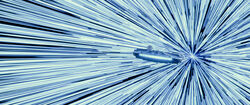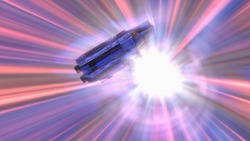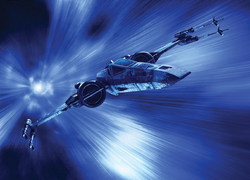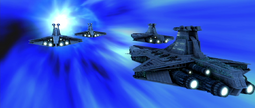| | |
- "For fast travel over interstellar distances, hyperspace is optimal."
- ―Tseebo

The blue simu-tunnel of hyperspace travel
Hyperspace was an alternate dimension that could only be reached by traveling at or faster than the speed of light. Hyperdrives enabled starships to travel through hyperspace lanes across great distances, enabling travel and exploration throughout the galaxy.
Nature[]
- "We live on a ship powered by energies that sunder cause and effect, beginning and end… hyperspace is a mystery more profound than gods and demons."
- ―Micha Evon

The Millennium Falcon exiting hyperspace
During the High Republic Era, hyperspace was not truly understood by anyone in the galaxy.[3] It was still regarded as a mystery during the Imperial Era.[2] It was at any rate a dimension of space-time[4] alternative to that of realspace.[5] In hyperspace, the normal laws of space and time did not apply, and beings traveling through hyperspace sometimes used stasis fields to slow the passage of time onboard a hyperspace-going vessel in order to have the pilot only age as fast as the rest of the galaxy.[6]
It could only be accessed through molecular displacement, which was achieved by breaking the speed of light.[5] The process created a simu-tunnel, a pocket of realspace allowing safe travel through the alternate dimension.[7] The Loth-wolves encountered by the Spectres[8] in 1 BBY[9] could travel in a similar manner to lightspeed via hyperspace tunneling.[8] Hyperspace was coterminous with realspace, meaning that each point in realspace was associated with a unique point in hyperspace, and all adjacent points in realspace were adjacent in hyperspace as well. Additionally, every object in realspace—such as stars, planets, and asteroids—had its "shadow" counterpart in hyperspace. Aside from those well-established facts acknowledged by all competent astrophysicists and astrogation experts, other aspects of hyperspace admittedly remained a mystery.[4]
Hyperspace usage[]
- "Traveling through hyperspace ain't like dusting crops, boy! Without precise calculations we could fly right through a star or bounce too close to a supernova, and that'd end your trip real quick, wouldn't it?"
- ―Han Solo, to Luke Skywalker

The Phantom detaches from the Ghost and falls out of hyperspace.
Hyperdrives manipulated hypermatter particles in order to thrust a starship into hyperspace[11] whilst preserving the ship's mass/energy profile.[11] This shortened travel distance significantly, allowing the vessel to "jump" from a specific point to another without having to travel directly between them, therefore reducing journey time by an extraordinarily large margin.[10] A vessel's ability to travel through hyperspace depended on it being equipped with a hyperdrive engine;[12] thus, vessels that suffered a hyperdrive failure while in hyperspace,[13] or lacked a hyperdrive and had separated from a vessel with one, would immediately fall out of hyperspace.[1] Cutting power to a functional hyperdrive would also have this effect.[14]
Quick jumps into hyperspace could be unsettling to even experienced pilots, but those with the proper stamina and training could overcome this.[15] Hyperspace whiplash was a condition experienced by some travelers upon exiting hyperspace.[16]
Large objects in realspace cast "mass shadows" in hyperspace, so hyperspace jumps[17]—known in shorthand as "hyperjumps"[18]—necessitated very precise calculations.[17] Without those, a vessel could fly right through a star or another celestial body.[10] Because of the danger, there existed predetermined hyperspace routes which interstellar travelers could take. The discovery of a new, safe hyperspace route could play a pivotal role in war, as it would allow naval forces to move faster unbeknownst to their adversaries.[19] The Galactic Empire employed Interdictor vessels which utilized gravity well projectors that created artificial mass shadows, both to pull them from hyperspace and to prevent them from making the jump to it.[20]
Upon entering hyperspace, a ship appeared to accelerate dramatically—a phenomenon known as pseudomotion[21]—and emitted Cronau radiation, which made their jump detectable by specialized sensors.[20] Hyperspace could be traversed via methods including navigation computers, Force-sensitive navigators, or jump-by-jump journeys. The Unknown Regions hosted unstable hyperspace pathways which required its residents to rely on navigators and jump-by-jump navigation rather than navicomputers.[22]

A T-70 X-wing starfighter traveling through hyperspace
Safely entering hyperspace from a standing start while docked or exiting hyperspace directly into the atmosphere of a planet were both feats that were generally considered impossible, even for an experienced pilot. Despite this, Han Solo accomplished both with the Millennium Falcon after being drawn into the First Order–Resistance conflict.[23] In fact, starships had safety protocols that prevented hyperdrive engines from firing within the gravitational pull of a planet. Although it was possible to turn those protocols off, such a move was highly dangerous, and any ship doing so had a high chance of blowing up, becoming severely damaged[24]or falling apart in hyperspace.[25] Successful jumps near a planet were possible, though: during the Clone Wars, a cruiser carrying an injured Anakin Skywalker had its hyperdrive accidentally triggered while still in a planet's atmosphere due to damage from droid fighters, and despite the proximity to the planet the ship successfully jumped to hyperspace without being destroyed.[14] Jyn Erso and her company jumped into hyperspace from inside the atmosphere of Jedha after the Death Star destroyed the moon's Holy city.[26] While fleeing Lothal in a U-wing, Hera Syndulla jumped to hyperspace right in front of an Imperial construction module and flew through the hangar, successfully getting out the other side and making the jump.[8] Desperate to save the remaining Resistance escape ships, Vice Admiral Amilyn Holdo engaged the hyperdrive of the Resistance cruiser Raddus directly into the path of the First Order Mega-class Star Dreadnought, the Supremacy, heavily damaging it and effectively vaporizing all traces of her ship.[27] This tactic became known as the Holdo maneuver.[28]
History[]
- "When I was young, I was told amazing stories of creatures that lived in the stars, traveled between the worlds. Old pilots said it was the purrgil who inspired us to jump from system to system. But I don't believe it."
- ―Hera Syndulla

A pod of purrgils traveling through hyperspace.
The ability to travel through hyperspace occurred in nature. The space-based species known as the purrgil could naturally travel through hyperspace.[29] At some point in the ancient past of the galaxy, an ancestral species unlocked the secrets of traveling through hyperspace and opened the galaxy up to exploration.[20] According to legend, the Rakatans, an ancient amphibious humanoid species native to the planet Lehon, were the first to develop hyperspace travel.[30]
Hyperspace travel was mastered as early as four millennia before the Cold War, as demonstrated by the existence of hyperspace sextants from that era.[31] In the early days of the Galactic Republic, hyperspace travel between the Greater Seswenna and the Core Worlds required astrogating by hyperspace beacons, with numerous reversions to realspace necessary to ensure safe passage.[20] Nevertheless, access to hyperspace travel proved to be vital to the Republic's expansion,[3] leading to a period of time known as the Great Hyperspace Rush.[32]

Venator-class Star Destroyers traveling in hyperspace
Around two centuries before the Invasion of Naboo,[33] starships across the galaxy were abruptly knocked out of hyperspace in the Great Hyperspace Disaster[34] masterminded by the Nihil.[3] Thanks to their path engines, the Nihil were able to perform acts with lightspeed thought to be impossible.[35] Generalirius Nakirre of the Kilji Illumine nation viewed hyperspace as a swirling disorder.[36]
At the time of the First Order–Resistance conflict, the First Order discovered sub-hyperspace, which they utilized with their superweapon, Starkiller Base.[37] The firing of Starkiller Base during the Hosnian Cataclysm in 34 ABY released enough energy to create a temporary rip in sub-hyperspace. This made the disaster visible from across the galaxy instantaneously, for a short time.[38]

